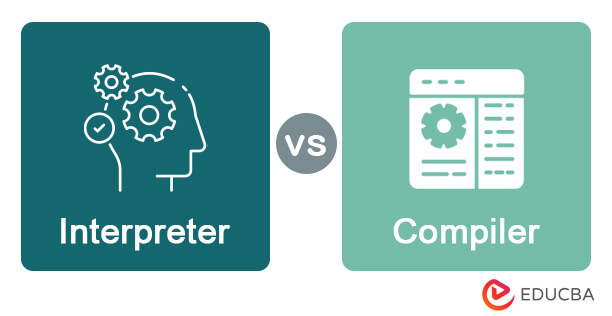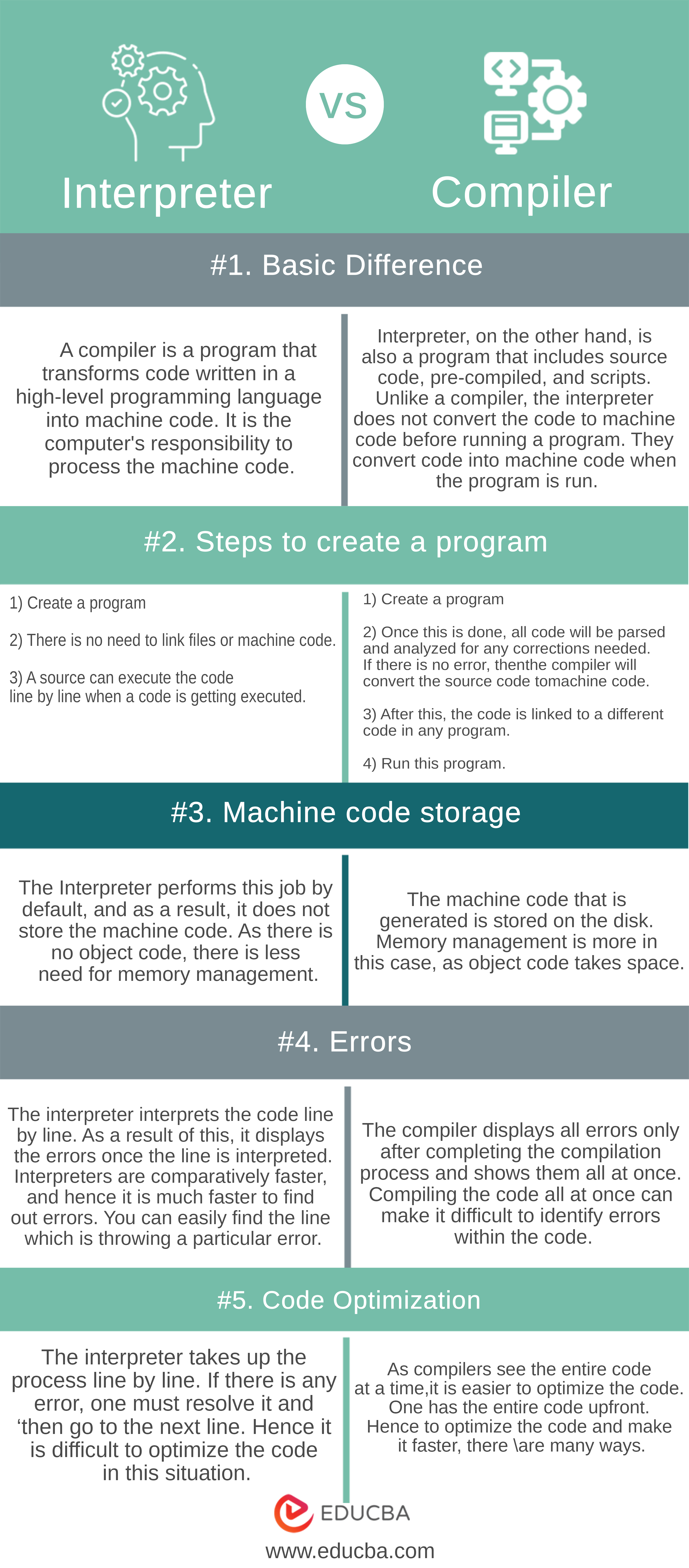Updated May 4, 2023
Difference Between Interpreter and Compiler
Interpreter and Compiler are two ways to execute a program written in a programming or scripting language. A compiler converts the entire program into object code and stores it in a file. Compilers are generally faster due to the compilation process. After linking, the machine can execute the resulting binary code An interpreter is much quicker. It directly executes instructions in any programming language without converting the code to an object or machine code.
Head To Head Comparison Between Interpreter vs Compiler (Infographics)
Below is the top 5 difference between Interpreter vs Compiler
Key Difference between Interpreter and Compiler
The most crucial difference between an interpreter vs Compiler is that Interpreter is made to execute the code now. In contrast, the Compiler first prepares the source code, and only then is execution done. Following are some other differences that are evident in the case of these two.
- After compiling a program, no further installations are necessary. The Compiler simplifies the process of distribution. In addition to this, the code can perform on one specific platform. Here the operating systems may be different, or the processor may need different compiler versions of the program. You can distribute the Interpreter to other users on various platforms without worrying about program distribution. But this involves the essential requirement that interpreters must run on particular platforms. The code can be distributed in its original form or when it has proceeded and is in the intermediate form.
- Regarding cross-platform programs, the preferred one has usually interpreted programming language. An interpreter translates code into the appropriate form for the target platform. In contrast, it is possible to address the slight differences between platforms for interpreters and compilers during compilation. This usually happens in parts, as the compiled language will mostly have lower cases. Additionally, you must ensure that the libraries being used support different platforms.
- When speed is a factor, the Compiler wins the race and loses it as well. Jumbled? Let us explain why it does both. A program, when compiled, is faster to run than an interpreted program. Interpreting a program takes more time to compile and run. A compiler hence produces shorter programs. Also, it is easier to optimize the compiler code. It is easier to optimize the code. One has the entire code upfront. Hence, many ways exist to optimize the code and make it faster.
- For debugging, one must use an interpreter than using any compiler. An interpreter has only one version of an executable file. Hence there is no need for debug version for any development. Using an interpreter can result in fewer platform-specific bugs. The absence of object code and the on-the-fly transformation of code means that all information regarding the source code is continually available. On the other hand, Compiler has an object code, and to top it, it has all the code simultaneously. Looking for an error in the Compiler can be a headache.
Interpreter vs Compiler Comparison Table
Let’s look at the top comparison between the Interpreter vs Compiler –
| The Basis of Comparison | Interpreter | Compiler |
| Basic Difference | A compiler is a program that transforms code written in a high-level programming language into machine code. It is the computer’s responsibility to process the machine code. | On the other hand, the Interpreter is also a program that includes source code, pre-compiled, and scripts. Unlike a compiler, the Interpreter does not convert the code to machine code before running a program. They convert code into machine code when the program is run. |
| Steps to Create a Program | 1) Create a program 2) There is no need to link files or machine code. 3) A source can execute the code line by line when a code is getting executed. |
1) Create a program 2) Once done, all code will be parsed and analyzed for necessary corrections. If there is no error, the Compiler will convert the source code to machine code. 3) After this, the code is linked to a different code in any program. 4) Run this program. |
| Machine code storage | The Interpreter performs this job by default, so it does not store the machine code. As there is no object code, there is less need for memory management. | The machine code that is generated is stored on the disk. Memory management is more in this case, as object code takes space. |
| Errors | The Interpreter interprets the code line by line. As a result, it displays the errors once the line is interpreted. Interpreters are comparatively faster, and hence it is much quicker to find out errors. You can easily find the line which is throwing a particular error. | The Compiler displays all errors only after completing the compilation process and shows them all simultaneously. Compiling the code all at once can make it challenging to identify the mistakes within the code. |
| Code Optimization | The Interpreter takes up the process line by line. If there is any error, one must resolve it and then go to the following line. Hence it isn’t easy to optimize the code in this situation. | As compilers see the entire code at a time, it is easier to optimize the code. One has the whole code upfront. Hence, many ways exist to optimize the code and make it faster. |
Conclusion
We have gone through many changes between the Interpreter vs Compiler. We can conclude after this above discussion that there are times when confident technical choices need to be relevant to your requirements. If a user wants speed and ease of development, you can mostly go for an interpreter-driven language. Also, all resources must be taken care of when any project is being started. The revised sentence is more concise and adds the transitional phrase “while” to indicate the contrast between the two statements. Hence it is upon the user how to use both interpreters vs compilers.
Recommended Articles
This has been a guide to the top difference between Interpreter vs Compiler. Here we also discuss the key differences between infographics and comparison tables. You may also have a look at the following articles to learn more-




